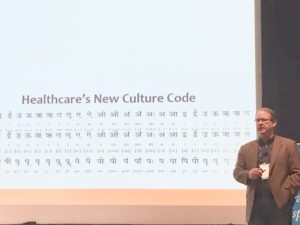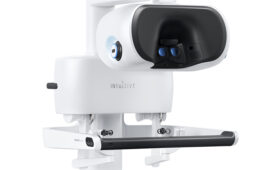Roy Smythe wants you to know he is not some hippy, New Age guru. But he does want to apply some New Age and pop psychology to the changing healthcare system, and offer a new way to think about the industry using culture code.
 Smythe, who is the chief medical officer for Valence Health, a Chicago-based healthcare consulting, services and operating company, spoke at the recent IDSA Medical Conference in San Francisco. “I don’t watch a lot of TV, but about 5 years ago I was watching a documentary about the development of the Boeing Dreamliner and by the end of it, I was sitting up in my bed.”
Smythe, who is the chief medical officer for Valence Health, a Chicago-based healthcare consulting, services and operating company, spoke at the recent IDSA Medical Conference in San Francisco. “I don’t watch a lot of TV, but about 5 years ago I was watching a documentary about the development of the Boeing Dreamliner and by the end of it, I was sitting up in my bed.”
The first part of that documentary was fascinating, if standard, fare about the engineering of the plane. But about halfway through, the focus shifted. Blake Emery, Boeing’s director of differentiation, was brought on to discuss the Boeing’s rethinking of the cabin and the end-to-end experience of flying.
What Emery said startled Smythe and inspired him to make some parallels to the healthcare system: “Even getting to the airport is a hassle – it’s difficult to find a place to park, the wayfinding is bad. You are anxious and stressed before you even get on the airplane.”
These are uncanny similarities to a trip to the hospital, noted Smythe, who also wrote an article on the topic last year in Forbes. “Having to go there provokes anxiety, parking is often a hassle, wayfinding is bad.” Likewise the messages are the same: “Sorry, we are delayed or late,” or “your surgery has been postponed,” or “you’ll be charged more.” Further, it requires people to give up a level of control to an “expert,” that has limited time and is “behind a locked door.” And, when things go wrong, they evoke the same feelings of anger and resolve to “never to come here again” – until of course you have no choice.
What Emery did with the Dreamliner cabin is what is referred to as idealized design. But he also applied cultural archetype discovery (that’s the pop psychology stuff – more on that later.)
Idealized design
For the uninitiated, there are a few principles of idealized design that can be summed as follows:
- Start with nothing, and build exactly what you want.
- Do not improve what exists, imagine that nothing exists.
- The only rules are it has to be feasible, not science fiction, operational, and capable of being improved upon.
For the cabin, for example, Emery said his team “started with an empty room.” From there, the team argued about how to provide relief from the hassle and anxiety of flying. One member of the team wanted to shut out the whole experience, such as use VR to help passengers pretend they were somewhere else. That might have been a good approach except for the second aspect of design.
Cultural codes
Clotaire Rapaille is the founder of a technique of extracting the formative impact that products or experiences have had on people, often at a young age. Rapaille calls these “cultural archetypes,” or “hidden codes.” The idea is that as children we form negative or positive emotions around products or experiences. “If the common archetype is negative for your product or service, you need to somehow offset that,” Smythe explained. “If it’s positive, you need to capitalize on it.”
This technique has its critics, but Rapaille has worked with hundreds of Fortune 500 companies. Emery, said Smythe, was critical too. “From what I understand, the process involves going into a quiet room, laying down, playing specific music to unlock those first memories – it sounds weird,” Smythe admitted.
Applying that cultural code to flying, for example, took the project in a new direction. Smythe asked if anyone had been flying with a 6-year-old. Several hands went up. “What do those kids do at the airport?” Smythe asked, answering by showing the image of a child with his nose smashed to the window of the terminal.
“When children fly, they are engaged in the process,” Smythe said. “They watch the planes take off, the trucks and the people on the runway, and they gaze out the window of the plane.”
The formative experience associated with flying for the first time is joy. After some deliberation, the Boeing team decided to engage the customer in the experience rather than distract them. “They wanted to capture that childlike emotion of wonder and joy,” Smythe said.
The Boeing 787, therefore, has huge archways that open up as passengers enter the plane, creating a sense of openness. Blue wavelength light in the cabin mimics the feeling of being in the sky. The seats offer more comfort controls and the windows are larger. There is also more oxygen flowing in the cabin, to help deliver fresh air.
The same lessons could be applied to healthcare. Smythe asked the audience to identify their first memories of healthcare from among some choices. One might be a memory of getting a shot, or a scary man in a white coat.
In fact, the archetypal code for healthcare has nothing to do with the hospital, or even doctors. Smythe says “caring home” is the hidden code. “Our first memory is a mother, father, or grandparent offering comfort, a bowl of soup, or extra attention. The strongest medicine of all was a parent’s love – soothing words, a reassuring smile and a tender touch.”
In hospitals, Smythe said, we need more cues that are hitting those notes. Hospitals are doing some things to promote healing via distraction such as TV, healing gardens, but these modes can be isolating. “They don’t provide love or caring.”
This is the call to action for designers, engineers, and anyone developing for the medical space. He says to look at ways to recreate a physical and emotional environment that looks and feels more like a “caring home” in hospitals and clinics. Some options Smythe suggested were more comfortable seats, dynamic lighting in wavelengths and colors that improve mood, more volunteers trained in touch and conversation, additional comfort items for waiting rooms, such as pillows and blankets. In the medial device arena, Smythe said he hopes designers and engineers will reimagine the devices used by patients to take this approach into consideration.
“I am challenging health care providers to actively work at creating emotional and physical environments that feel more like a caring home, and less like an impersonal factory. Let’s buy fewer flat-screen televisions for waiting rooms, and actually engage patients and their family members in the positive experience of health care.”




